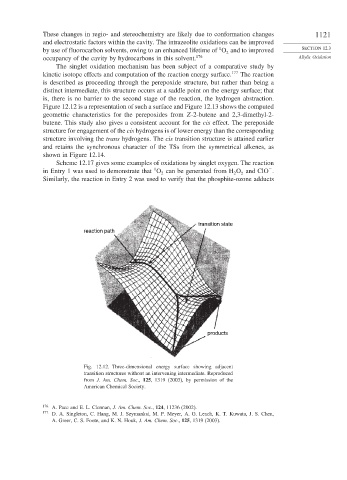Page 1145 - Advanced Organic Chemistry Part B - Reactions & Synthesis
P. 1145
These changes in regio- and stereochemistry are likely due to conformation changes 1121
and electrostatic factors within the cavity. The intrazeolite oxidations can be improved
1
by use of fluorocarbon solvents, owing to an enhanced lifetime of O and to improved SECTION 12.3
2
occupancy of the cavity by hydrocarbons in this solvent. 176 Allylic Oxidation
The singlet oxidation mechanism has been subject of a comparative study by
kinetic isotope effects and computation of the reaction energy surface. 177 The reaction
is described as proceeding through the perepoxide structure, but rather than being a
distinct intermediate, this structure occurs at a saddle point on the energy surface; that
is, there is no barrier to the second stage of the reaction, the hydrogen abstraction.
Figure 12.12 is a representation of such a surface and Figure 12.13 shows the computed
geometric characteristics for the perepoxides from Z-2-butene and 2,3-dimethyl-2-
butene. This study also gives a consistent account for the cis effect. The perepoxide
structure for engagement of the cis hydrogens is of lower energy than the corresponding
structure involving the trans hydrogens. The cis transition structure is attained earlier
and retains the synchronous character of the TSs from the symmetrical alkenes, as
shown in Figure 12.14.
Scheme 12.17 gives some examples of oxidations by singlet oxygen. The reaction
−
1
in Entry 1 was used to demonstrate that O can be generated from H O and ClO .
2
2
2
Similarly, the reaction in Entry 2 was used to verify that the phosphite-ozone adducts
transition state
reaction path
products
Fig. 12.12. Three-dimensional energy surface showing adjacent
transition structures without an intervening intermediate. Reproduced
from J. Am. Chem. Soc., 125, 1319 (2003), by permission of the
American Chemical Society.
176 A. Pace and E. L. Clennan, J. Am. Chem. Soc., 124, 11236 (2002).
177
D. A. Singleton, C. Hang, M. J. Szymanksi, M. P. Meyer, A. G. Leach, K. T. Kuwata, J. S. Chen,
A. Greer, C. S. Foote, and K. N. Houk, J. Am. Chem. Soc., 125, 1319 (2003).

